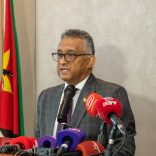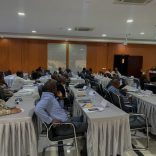Mozambique tops the list of 10 countries responsible for 80% airline funds blocked from ...
Bank of Mozambique leaves interest rates unchanged – Watch

TVM
The Monetary Policy Committee of the Bank of Mozambique, meeting in Maputo on Monday, has left all the central bank’s benchmark interest rates unchanged.
Thus the new interest rate, introduced in April, the Interbank Money Market Rate (MIMO), remains at 21.75 per cent. The central bank’s interventions on the interbank money market to regulate liquidity are based on this rate.
The Standing Lending Facility (the interest rate paid by the commercial banks to the central bank for money borrowed on the Interbank Money Market) is unchanged, at 22.75 per cent, and, the Standing Deposit Facility (the rate paid by the central bank to the commercial banks on money they deposit with it) remains at 16.25 per cent. Likewise, the Compulsory Reserves Coefficient – the amount of money that the commercial banks must deposit with the Bank of Mozambique – also remains unchanged, at 15.5 per cent.
Speaking at a press conference on Monday evening, the governor of the Bank of Mozambique, Rogerio Zandamela, said “the inflation trend is downwards, albeit timidly, but the risks and uncertainties around inflation remain high”. Hence the decision by the Monetary Policy Committee not to cut interest rates.
The latest inflation figures, published by the National Statistics Institute (INE), and based on the consumer price indices of the three major cities (Maputo, Nampula and Beira), show that in May inflation was negative, at minus 0.38 per cent. Inflation from January to the end of May was 5.09 per cent, and annual inflation (1 June 2016 to 31 May 2017 was 20.45 per cent).
Zandamela expected the annual inflation rate to fall to 14 per cent by the end of the year. At the same time, there would be a modest increase in the economic growth rate. He predicted that Mozambican gross domestic product would grow by 4.3 per cent over the year.
The GDP growth rate in the first quarter was 2.9 per cent. Mining was the main contributor with growth of 41.6 per cent, compared with the first quarter of 2016. This compensated for the performance of others sectors – such as construction, manufacturing and agriculture, which contracted by 25.3, 4.3 and 0.8 per cent respectively.
Some of the prices of key Mozambican exports, notably coal, have been recovering on the international market, and this doubtless contributed to an improvement in the balance of payments in the first quarter. The current account deficit, Zandamela said, fell by 263.7 million dollars to 718 million dollars. Major contributions to this were made by exports of coal, natural gas, aluminium, and titanium minerals.
At the same time, the national currency, the metical, which had hit a low point of around 80 to the US dollar in September, continued to recover. The metical appreciated from 67.8 meticais to the dollar in March to 60.8 on 31 May. Against the South African rand, the appreciation over the same period was from 5.2 to 4.6 meticais to the rand.
Mozambique’s net international reserves have increased steadily since the beginning of the year. Zandamela said that last Friday the reserves reached 2.342 billion dollars, enough to cover 6.1 months of imports of goods and non-factor services (excluding the foreign investment based mega-projects).
“Prospects are good”, declared Zandamela. “We are no longer managing a crisis”.












Leave a Reply
Be the First to Comment!
You must be logged in to post a comment.
You must be logged in to post a comment.